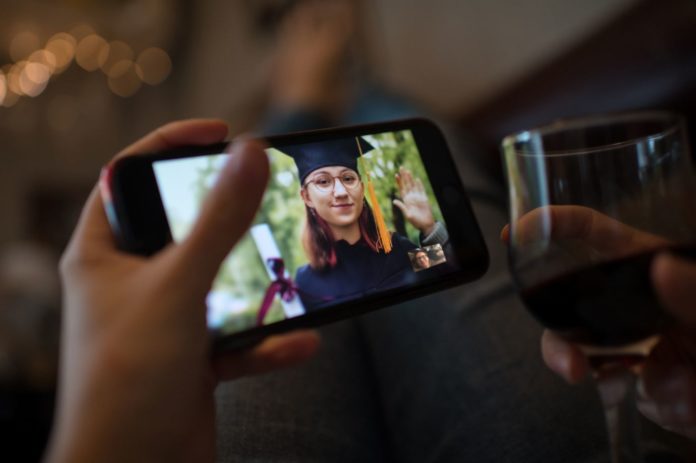Melanie Heath is a fourth-year Honours Bachelor of Arts student studying Psychology at Queen’s University and a part-time CDW Campus Intern. As restrictions lighten up, she is excited to reunite with friends, hug her grandparents, make travel plans and maybe even walk down a real stage at a rescheduled convocation ceremony.
There are a few key dates I’m going to remember for a long time. On March 11, 2020, precisely 10 minutes after I bought my senior formal ticket, the World Health Organization declared the novel coronavirus outbreak a global pandemic. On March 13, Queen’s University cancelled classes for the upcoming week as they grappled with how to move forward. This was also the day I attended the last in-person lecture of my undergraduate career. Finally, on March 23, the Principal told students it was time to go home, where courses and exams were to be delivered remotely. In less than two weeks, my final year on campus had come to an abrupt end. It felt like I was running a marathon, and just as I was approaching the last mile, I was told to stop, go home and finish up on the treadmill in my garage.
Since then, nearly every aspect of normal life has been affected by the spread of COVID-19. I think it’s safe to say both students and faculty were not prepared for this rapid transition to online learning. Coming up to the end of the year, I had collaborative group projects to complete, presentations to give and exams to write. I was anxious about completing my assignments and worried about how my GPA might suffer as a result.
Changing times for professors and students
I’m sure it was a struggle for faculty as well, as many had spent their entire careers teaching in person, never venturing into remote learning materials before this. Some of my professors recorded lectures and uploaded them every week, while others attempted live synchronous lectures, each bearing its own challenges. With all of higher education suddenly needing proctors, there simply weren’t enough to keep up with the demand. Professors therefore had to get creative.
In one of my classes, instead of writing an exam we were told to write a five-page paper on coping with stress during a pandemic. In another, we were assigned an open-book online exam. This would be fine, except students were only a quick Google search away from finding answers. As you can imagine, this was a serious test of academic integrity for students, while potentially impacting the validity of exam results.
Technology to the rescue
As this situation has unfolded, technology companies have naturally rushed to help out, making their solutions accessible with trials and new partnerships. In a typical lecture, using Kahoot! and Top Hat was the extent of our digital solutions. Throughout eLearning, Zoom and Microsoft Teams quickly became vital to my experience. With the help of these platforms, I was able to stay connected to my classmates, complete my final assignments and execute virtual group presentations.
As I started to get the hang of things, the Queen’s administration was learning best practices as well. When Zoom hackers started joining in on Monday morning lectures, professors learned to use passwords and enable additional security features, something first-time users might not do. When professors needed an easier way to collaborate with students, the IT services team integrated Microsoft Teams in the course creation tool so that faculty members could automatically create Teams based on class enrolments.
As summer classes begin, even more long-term changes are being made. Queen’s Arts and Science Online is aiming to become even more accessible to students through measures like increasing enrolment caps for popular classes, adding new courses, hiring more teaching assistants to support larger online class sizes and extending the start date for summer courses.
How Queen’s is building resiliency while moving online
Even with these impressive changes, I would much rather be learning on campus than learning online at home. I took for granted the in-person classes, passionate tutorial discussions with classmates and even walking around the library for 20 minutes before finding a seat. With that being said, I understand that for the safety of everyone on Queen’s campus and in the community things can’t return to normal quite yet.
With the school having committed to eLearning in the fall semester, my hope is that students will continue to have regular contact with professors as well as with other students in class. Ensuring that everyone stays in close communication and maintains bonds as a community, through activities like new online events, will enable the Queen’s spirit and culture to stay alive. To do this, we’re going to have to collaborate more than ever with technology companies to find the most sophisticated options to be increasingly effective in the wake of this move online.
The resiliency demonstrated by students, faculty and administration is commendable. While redesigning the learning environment presents its challenges, it is also a massive opportunity to break out of old habits and create innovative and impactful modes of learning that take advantage of technology.
For graduating students like myself, becoming technologically savvy, honing new digital skills and being able to stay motivated to work from anywhere is a skillset we will take with us as we enter the workforce. Personally, these changes have pushed me to improve on my collaboration, creative problem-solving and openness to new ideas.
CDW Campus Interns are responsible for cultivating the connection between IT departments, University Administration and CDW to maximize the student technology experience on campus. This unique program developed by CDW provides opportunities for students to graduate with hands-on experience and explore career opportunities in technology.







